View in other NatureServe Network Field Guides
NatureServe
Montana
Utah
Wyoming
Idaho
Wisconsin
British Columbia
South Carolina
Yukon
California
New York
Persius Duskywing - Erynnis persius
Native Species
Global Rank:
G5
State Rank:
S4
Agency Status
USFWS:
USFS:
BLM:
External Links
General Description
[From Ferris and Brown 1981; Scott 1986; Layberry et al. 1998; Opler and Wright 1999; Glassberg 2001; Pyle 2002] Forewing 1.4-1.8 cm. Medium-sized, fringes dark brown on male hindwing. Uppersurface of forewing with grayish-brown patch at end of cell, clear spots appear in forewing band; male forewing with numerous raised grayish-white hairs over much of surface, creating a soft and frosted appearance, male hindlegs with tibial hair tufts; basal third of female forewing dark, with patches of gray on both sides of dark wing band, hindwing with small pale spots and less prominant cell-end bar.
Phenology
One flight, mostly May to mid-June in the eastern US, mostly June in Canada and western US, June to July at high elevation; two flights, May to September in northern California, March to September in central California (Scott 1986). mainly May to July (Glassberg 2001). Mid-May to early August in Canada (Layberry et al. 1998). Mid-May through July in the Rocky Mountain states (Ferris and Brown 1981). Mid-May to mid-August in Colorado (Emmel 1964; Scott and Scott 1978; Scott and Epstein 1987), late April to early July in western Nebraska (Johnson and Nixon 1967), early May to late June in western North Dakota (McCabe and Post 1976), late April to mid-August in Oregon and Washington (Pyle 2002), mid-April to mid-August in Oregon (Warren 2005), early May to late June in British Columbia (Guppy and Shepard 2001).
Diagnostic Characteristics
Best determined by combination of distinctive genetalia; males with hind-leg tibial hair tufts and numerous raised grayish-white hairs over much of surface of forewing, creating a soft and frosted appearance; clear spots appear in forewing band,basal third of female forewing dark, with patches of gray on both sides of dark wing band, hindwing with small pale spots and less prominant cell-end bar.
Species Range
Montana Range
Range Descriptions
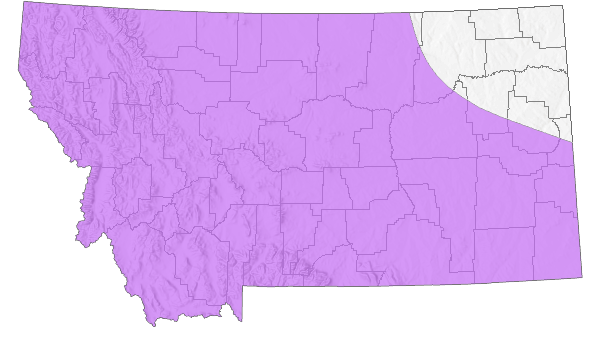
 Native
Native
Range Comments
Alaska through the Yukon to western Northwest Territories, south in montane areas to southern California, southern Arizona, southern New Mexico, east to southeastern Manitoba, western South Dakota, western Nebraska, eastern Colorado; also isolated populations in northeastern US (Ferris and Brown 1981; Scott 1986; Layberry et al. 1998; Opler and Wright 1999; Glassberg 2001); 1585 m to at least 3764 m elevation in Colorado (Brown 1957; Scott and Scott 1978), near sea level to more than 2743 m elevation in Oregon (Warren 2005). In Montana, reported from at least 28 counties across the state except the northeastern 1/6 (Kohler 1980; Stanford and Opler 1993; FLMNH Lepidopterists' Society database), to at least 1828 m elevation. Mainly uncommon to common (Glassberg 2001).
Observations in Montana Natural Heritage Program Database
Number of Observations: 16
(Click on the following maps and charts to see full sized version)
Map Help and Descriptions
Relative Density
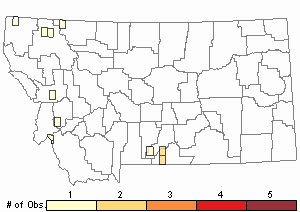
Recency

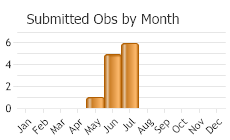
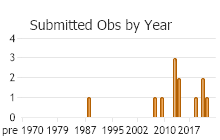
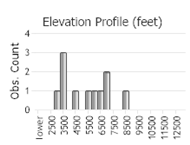 (Observations spanning multiple months or years are excluded from time charts)
(Observations spanning multiple months or years are excluded from time charts)
Migration
Non-migratory.
Habitat
Montane meadows, streamsides, woodland openings, roadsides, grasslands, sandy areas, above treeline in alpine terrain (Emmel 1964; Ferris and Brown 1981; Scott 1986; Layberry et al. 1998; Opler and Wright 1999; Glassberg 2001); also in ponderosa pine Pleistocene relict woodlands of the western Great Plains (Johnson and Nixon 1967; Johnson 1975). Habitat in Montana not described but probably similar.
Food Habits
Laval food plants are members of the Fabaceae, including Astragalus (multiple species), Lotus (multiple species), Lupinus (several species), Thermopsis (multiple species), and Trifolium, and members of the Salicaceae in eastern North America, including Populus (several species) and Salix (Scott 1986, 1992, 2006; Layberry et al. 1998; Guppy and Shepard 2001; Pyle 2002; Warren 2005; James and Nunnallee 2011). Adults feed on flower nectar (including Allium, Antennaria, Apocynum, Arctostaphylos, Astragalus, Barbarea, Berberis, Berteroa, Cerastium, Claytonia, Collinsia, Comandra, Cryptantha, Erigeron, Eriogonum, Erysimum, Harbouria, Heterotheca, Jamesia, Lathyrus, Lesquerella, Lithospermum, Lupinus, Mertensia, Oxytropis, Penstemon, Phacelia, Phlox, Physaria, Potentilla, Pseudostellaria, Pulsatilla, Ranunculus, Ribes, Sedum, Senecio, Thermopsis, Thlaspi, Townsendia, Verbena, Viola) and mud (Tooker et al. 2002; Warren 2005; James and Nunnallee 2011; Scott 2014).
Reproductive Characteristics
Females lay eggs singly on the undersurface of host plant leaves, often near new growth and flower buds, sometimes on host plant stems (Scott 1986, 1992, 2006). Eggs hatch in about 7-8 days, develop from L2 instar to L5 instar in about 14 days, overwinters as mature L5 instar, pupate in about 6 days after exiting dormancy the following spring, adults eclose (emerge from pupae) in about 13 days (Guppy and Shepard 2001; James and Nunnallee 2011). Larvae feed on host plant leaves, build nests of rolled leaves tied with silk, feed nocturnally, overwinter (hibernate) as mature L5 instar (Scott 1979, 1986; James and Nunallee 2011). Males perch throughout the day on hilltops, the ground, low twigs near shrubs along flight corridors, awaiting passing females (Scott 1975b, 1986; Warren 2005; James and Nunnallee 2011).
Stewardship Responsibility
References
- Literature Cited AboveLegend:
 View Online Publication
View Online Publication Brown, F.M. 1957. Colorado Butterflies. Proceedings; Numbers Three through Seven. Denver Museum of Natural History, Denver, Co.
Brown, F.M. 1957. Colorado Butterflies. Proceedings; Numbers Three through Seven. Denver Museum of Natural History, Denver, Co. Emmel, T.C. 1964. The ecology and distribution of butterflies in a montane community near Florissant, Colorado. American Midland Naturalist 72(2): 358-373.
Emmel, T.C. 1964. The ecology and distribution of butterflies in a montane community near Florissant, Colorado. American Midland Naturalist 72(2): 358-373. Ferris, C.D. and F.M. Brown (eds). 1981. Butterflies of the Rocky Mountains. Univ. of Oklahoma Press. Norman. 442 pp.
Ferris, C.D. and F.M. Brown (eds). 1981. Butterflies of the Rocky Mountains. Univ. of Oklahoma Press. Norman. 442 pp. Glassberg, J. 2001. Butterflies through Binoculars: A Field Guide to the Butterflies of Western North America. Oxford University Press.
Glassberg, J. 2001. Butterflies through Binoculars: A Field Guide to the Butterflies of Western North America. Oxford University Press. Guppy, C.S. and J.H. Shepard. 2001. Butterflies of British Columbia: including western Alberta, southern Yukon, the Alaska Panhandle, Washington, northern Oregon, northern Idaho, northwestern Montana. UBC Press (Vancouver, BC) and Royal British Columbia Museum (Victoria, BC). 414 pp.
Guppy, C.S. and J.H. Shepard. 2001. Butterflies of British Columbia: including western Alberta, southern Yukon, the Alaska Panhandle, Washington, northern Oregon, northern Idaho, northwestern Montana. UBC Press (Vancouver, BC) and Royal British Columbia Museum (Victoria, BC). 414 pp. James, D.G. and D. Nunnallee. 2011. Life histories of Cascadia butterflies. Corvallis, OR: Oregon State University Press. 447 p.
James, D.G. and D. Nunnallee. 2011. Life histories of Cascadia butterflies. Corvallis, OR: Oregon State University Press. 447 p. Johnson, K. 1975. Post-Pleistocene environments and montane butterfly relicts on the western Great Plains. Journal of Research on the Lepidoptera 14(4): 216-232.
Johnson, K. 1975. Post-Pleistocene environments and montane butterfly relicts on the western Great Plains. Journal of Research on the Lepidoptera 14(4): 216-232. Johnson, K. and E. S. Nixon. 1967. The Rhopalocera of northwestern Nebraska. American Midland Naturalist 78:508-528.
Johnson, K. and E. S. Nixon. 1967. The Rhopalocera of northwestern Nebraska. American Midland Naturalist 78:508-528. Kohler, S. 1980. Checklist of Montana Butterflies (Rhopalocera). Journal of the Lepidopterists' Society 34(1): 1-19.
Kohler, S. 1980. Checklist of Montana Butterflies (Rhopalocera). Journal of the Lepidopterists' Society 34(1): 1-19. Layberry, R.A., P.W. Hall, and J.D. LaFontaine. 1998. The Butterflies of Canada. University of Toronto Press. 280 pp. + color plates.
Layberry, R.A., P.W. Hall, and J.D. LaFontaine. 1998. The Butterflies of Canada. University of Toronto Press. 280 pp. + color plates. McCabe, T.L. and R.L. Post. 1976. North Dakota butterfly calendar (including possible strays). Journal of Research on the Lepidoptera 15:93-99.
McCabe, T.L. and R.L. Post. 1976. North Dakota butterfly calendar (including possible strays). Journal of Research on the Lepidoptera 15:93-99. Opler, P.A. and A.B. Wright. 1999. A field guide to western butterflies. Second edition. Peterson Field Guides. Houghton Mifflin Company, Boston, Massachusetts. 540 pp.
Opler, P.A. and A.B. Wright. 1999. A field guide to western butterflies. Second edition. Peterson Field Guides. Houghton Mifflin Company, Boston, Massachusetts. 540 pp. Pyle, R.M. 2002. The butterflies of Cascadia: a field guide to all the species of Washington, Oregon, and surrounding territories. Seattle Audubon Society, Seattle, Washington. 420 pp.
Pyle, R.M. 2002. The butterflies of Cascadia: a field guide to all the species of Washington, Oregon, and surrounding territories. Seattle Audubon Society, Seattle, Washington. 420 pp. Scott, J.A. 1975b. Mate-locating behavior of western North American butterflies. Journal of Research on the Lepidoptera 14:1-40.
Scott, J.A. 1975b. Mate-locating behavior of western North American butterflies. Journal of Research on the Lepidoptera 14:1-40. Scott, J.A. 1979. Hibernal diapause of North American Papilionoidea and Hesperioidea. Journal of Research on the Lepidoptera 18(3): 171-200.
Scott, J.A. 1979. Hibernal diapause of North American Papilionoidea and Hesperioidea. Journal of Research on the Lepidoptera 18(3): 171-200. Scott, J.A. 1986. The butterflies of North America: a natural history and field guide. Stanford University Press, Stanford, California.
Scott, J.A. 1986. The butterflies of North America: a natural history and field guide. Stanford University Press, Stanford, California. Scott, J.A. 1992. Hostplant records for butterflies and skippers (mostly from Colorado) 1959-1992, with new life histories and notes on oviposition, immatures, and ecology. Papilio new series #6. 185 p.
Scott, J.A. 1992. Hostplant records for butterflies and skippers (mostly from Colorado) 1959-1992, with new life histories and notes on oviposition, immatures, and ecology. Papilio new series #6. 185 p. Scott, J.A. 2006. Butterfly hostplant records, 1992-2005, with a treatise on the evolution of Erynnis, and a note on new terminology for mate-locating behavior. Papilio new series #14. 74 p.
Scott, J.A. 2006. Butterfly hostplant records, 1992-2005, with a treatise on the evolution of Erynnis, and a note on new terminology for mate-locating behavior. Papilio new series #14. 74 p. Scott, J.A. 2014. Lepidoptera of North America 13. Flower visitation by Colorado butterflies (40,615 records) with a review of the literature on pollination of Colorado plants and butterfly attraction (Lepidoptera: Hersperioidea and Papilionoidea). Contributions of the C.P. Gillette Museum of Arthopod Diversity. Fort Collins, CO: Colorado State University. 190 p.
Scott, J.A. 2014. Lepidoptera of North America 13. Flower visitation by Colorado butterflies (40,615 records) with a review of the literature on pollination of Colorado plants and butterfly attraction (Lepidoptera: Hersperioidea and Papilionoidea). Contributions of the C.P. Gillette Museum of Arthopod Diversity. Fort Collins, CO: Colorado State University. 190 p. Scott, J.A. and G.R. Scott. 1978. Ecology and distribution of the butterflies of southern central Colorado. Journal of Research on the Lepidoptera 17(2): 73-128.
Scott, J.A. and G.R. Scott. 1978. Ecology and distribution of the butterflies of southern central Colorado. Journal of Research on the Lepidoptera 17(2): 73-128. Scott, J.A. and M.E. Epstein. 1987. Factors affecting phenology in a temperate insect community. American Midland Naturalist 117(1): 103-118.
Scott, J.A. and M.E. Epstein. 1987. Factors affecting phenology in a temperate insect community. American Midland Naturalist 117(1): 103-118. Stanford, R.E. and P.A. Opler. 1993. Atlas of western USA butterflies: including adjacent parts of Canada and Mexico. Unpubl. Report. Denver and Fort Collins, Colorado 275 pp.
Stanford, R.E. and P.A. Opler. 1993. Atlas of western USA butterflies: including adjacent parts of Canada and Mexico. Unpubl. Report. Denver and Fort Collins, Colorado 275 pp. Tooker, J.F., P.F. Reagel, and L.M. Hanks. 2002. Nectar sources of day-flying lepidoptera of central Illinois. Annals of the Entomological Society of America 95(1): 84-96.
Tooker, J.F., P.F. Reagel, and L.M. Hanks. 2002. Nectar sources of day-flying lepidoptera of central Illinois. Annals of the Entomological Society of America 95(1): 84-96. Warren, A.D. 2005. Lepidoptera of North America 6: Butterflies of Oregon, their taxonomy, distribution, and biology. Contributions of the C. P. Gillette Museum of Arthropod Diversity, Colorado State University. Fort Collins, Colorado. 406 pp.
Warren, A.D. 2005. Lepidoptera of North America 6: Butterflies of Oregon, their taxonomy, distribution, and biology. Contributions of the C. P. Gillette Museum of Arthropod Diversity, Colorado State University. Fort Collins, Colorado. 406 pp.
- Additional ReferencesLegend:
 View Online Publication
View Online Publication
Do you know of a citation we're missing? Allen, T.J., J.P. Brock, and J. Glassberg. 2005. Caterpillars in the field and garden: a field guide to the butterfly caterpillars of North America. Oxford University Press.
Allen, T.J., J.P. Brock, and J. Glassberg. 2005. Caterpillars in the field and garden: a field guide to the butterfly caterpillars of North America. Oxford University Press. Brock, J.P. and K. Kaufman. 2003. Kaufman Field Guide to Butterflies of North America. Houghton Mifflin Company, New York, NY 284 pp.
Brock, J.P. and K. Kaufman. 2003. Kaufman Field Guide to Butterflies of North America. Houghton Mifflin Company, New York, NY 284 pp. Forister, M.L., C.A. Halsch, C.C. Nice, J.A. Fordyce, T.E. Dilts, J.C. Oliver, K.L. Prudic, A.M. Shapiro, J.K. Wilson, J. Glassberg. 2021. Fewer butterflies seen by community scientists across the warming and drying landscapes of the American West. Science 371:1042-1045.
Forister, M.L., C.A. Halsch, C.C. Nice, J.A. Fordyce, T.E. Dilts, J.C. Oliver, K.L. Prudic, A.M. Shapiro, J.K. Wilson, J. Glassberg. 2021. Fewer butterflies seen by community scientists across the warming and drying landscapes of the American West. Science 371:1042-1045. Forister, M.L., E.M. Grames, C.A. Halsch, K.J. Burls, C.F. Carroll, K.L. Bell, J.P. Jahner, et al. 2023. Assessing risk for butterflies in the context of climate change, demographic uncertainty, and heterogeneous data sources. Ecological Monographs 93(3):e1584. https://doi.org/10.1002/ecm.1584
Forister, M.L., E.M. Grames, C.A. Halsch, K.J. Burls, C.F. Carroll, K.L. Bell, J.P. Jahner, et al. 2023. Assessing risk for butterflies in the context of climate change, demographic uncertainty, and heterogeneous data sources. Ecological Monographs 93(3):e1584. https://doi.org/10.1002/ecm.1584 Maxell, B.A. 2016. Northern Goshawk surveys on the Beartooth, Ashland, and Sioux Districts of the Custer-Gallatin National Forest: 2012-2014. Montana Natural Heritage Program. Helena, MT. 114pp.
Maxell, B.A. 2016. Northern Goshawk surveys on the Beartooth, Ashland, and Sioux Districts of the Custer-Gallatin National Forest: 2012-2014. Montana Natural Heritage Program. Helena, MT. 114pp.
- Web Search Engines for Articles on "Persius Duskywing"
- Additional Sources of Information Related to "Insects"





